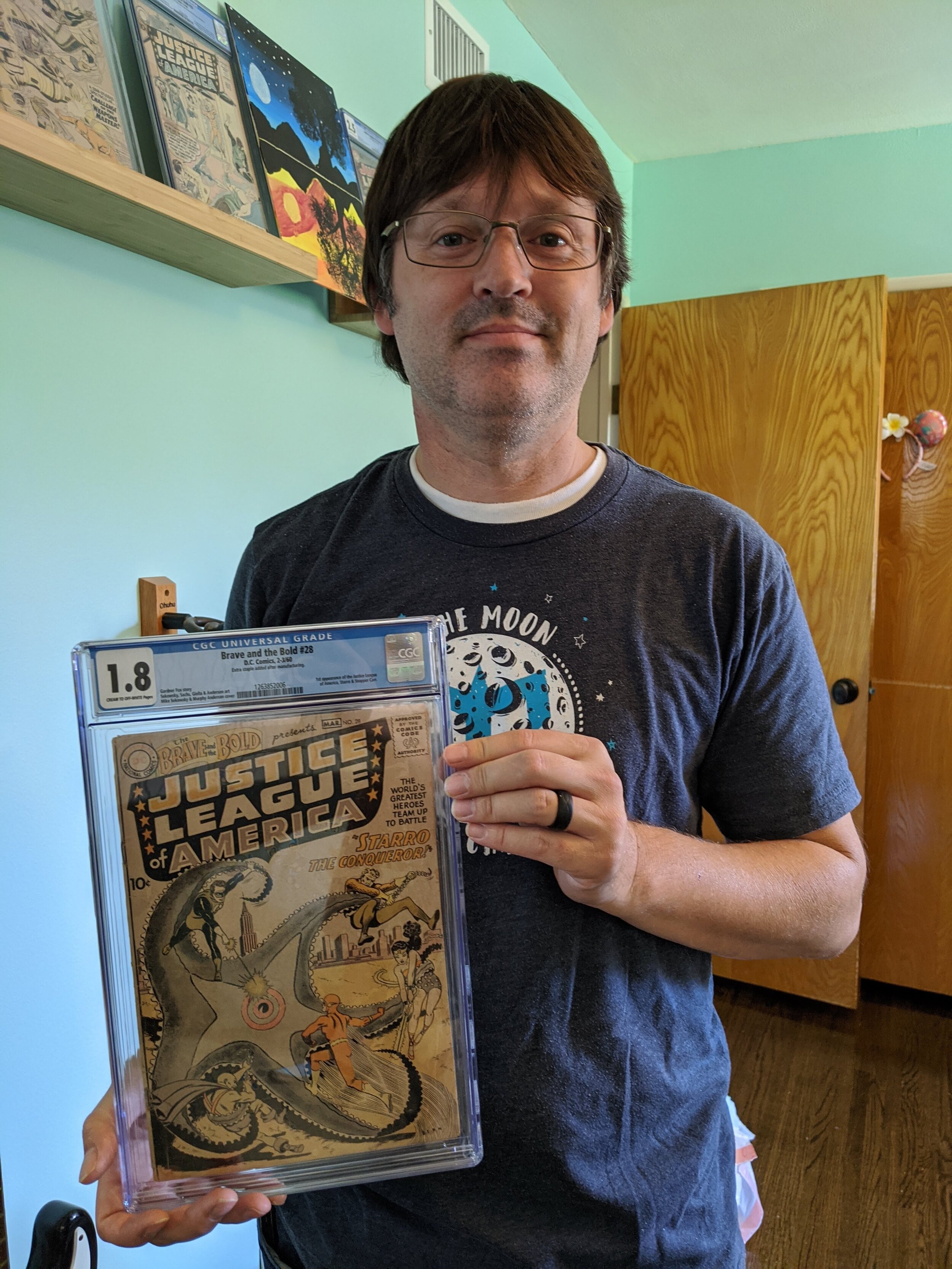Eric Bladh with his “crown jewel” comic, The Brave and the Bold #28. “It is the first appearance of the Justice League in 1960, although it was published in December of 1959…For any collector the 1st appearance should be the beginning of everyone's collection. I got the comic from my dad for Christmas when I was in High School. Although it isn't in the best condition it is still my number one comic.”
Starro and Justice League superheroes on the cover of The Brave and the Bold #28 (officially February–March 1960).
Inside The Brave and the Bold #28 (1960), a Starro clone reaches in to steal the atom bomb from a military plane.
The Brave and the Bold series presented Justice League of America in three comic books before the league of superheroes budded off for their own eponymous title.
Left: The first publication of the Justice League of America independent of The Brave and the Bold series (November 1960).
Center: Justice League of America #5 (July 1961). The Green Arrow is under suspicion and Gravity goes Wild!
Right: Inspired by DC’s superhero revival, Marvel Comics began publishing The Fantastic Four in November 1961.
Created by writer Stan Lee and artist Jack Kirby, the success of The Fantastic Four’s persuaded Lee to stay in the comic business.
Eric Bladh compares two copies of the first publication of The Fantastic Four (November 1961).
Eric Bladh and his dad. Eric holds Justice League of America #7 (November 1961), “The Cosmic Fun-House.” Mr Bladh is holding a copy of DC’s “Batman with Robin.”
Comic Books
Eric Bladh
Geography/GIS
Who hasn’t debated the merits of superhuman strength, being able to fly, or x-ray vision? Given a choice, what would your superpower be? For Eric Bladh there is no question: “it would always be superspeed.”
“My dad collected comics when he was a kid, but his mom threw away his comic collection when he left home...[when] he suddenly decided to start collecting again,…he took me and my brother to the comic bookstore and told us to…choose one comic to start collecting.”
Eric’s first purchase was DC’s Justice League of America #26, with Batman on the cover. “I’m a big Batman fan,” he explained, “mostly because he is the superhero without superpowers.” A fan of the “normal guy trying to be a superhero,” Bladh “grew to really like a little-known comic character named Booster Gold.” A time traveling museum janitor, Gold took superhero artifacts back to 20th century Gotham City, where they gave him the appearance of superpowers.
Comprising Batman, Superman, Wonder Woman, and four other superheroes, the Justice League was created by penciller Mike Sekowsky, “one of the fastest artists in the comics field,” and writer Gardner Fox (who conceived the DC Multiverse).[1] Their first super villain was Starro, a self-replicating alien-starfish, whose clone exploded an atom bomb and fed off its energy.
“The Silver Age comics of the early Justice League were very formulaic in that way,” says Eric Bladh.[2] “Bad guy comes, does bad thing, underestimates the team, and when everything looks it worst the team comes together and conquers!” Despite – or because of – the formula, “Justice League was a hit. It…provided a playground where DC's characters could attract new fans while entertaining established admirers.”[3] “Today,” says Bladh, “we are still adding and growing the relationship these characters have with each other, which keeps us coming back the next month to find out what happened.”
31-years after that first purchase, the Bladh family now has approximately 18,000 comics. “Whenever we see each other we will spend time talking about new storylines and what the writers are doing to the characters. [My father] will show me new comics…and I'll help him find some comics out of the collection that he is selling... Which, for me is a lot harder to do than for him. I guess I am a bit more of a Hoarder when it comes to the comics, but that is okay. I'm learning to let go.”
Notes
[1] Lee, Stan, Secrets Behind the Comics, 1947, Famous Enterprises, p. 58.
[2] Comic book collectors have constructed a framework to structure their studies, which includes the Golden Age (1938–1956) and the Silver Age (c.1956–1970).
[3] Daniels, Les, "The Justice League of America A Team of Good Sports," DC Comics: Sixty Years of the World's Favorite Comic Book Heroes. Bulfinch, 1995, p. 127.






